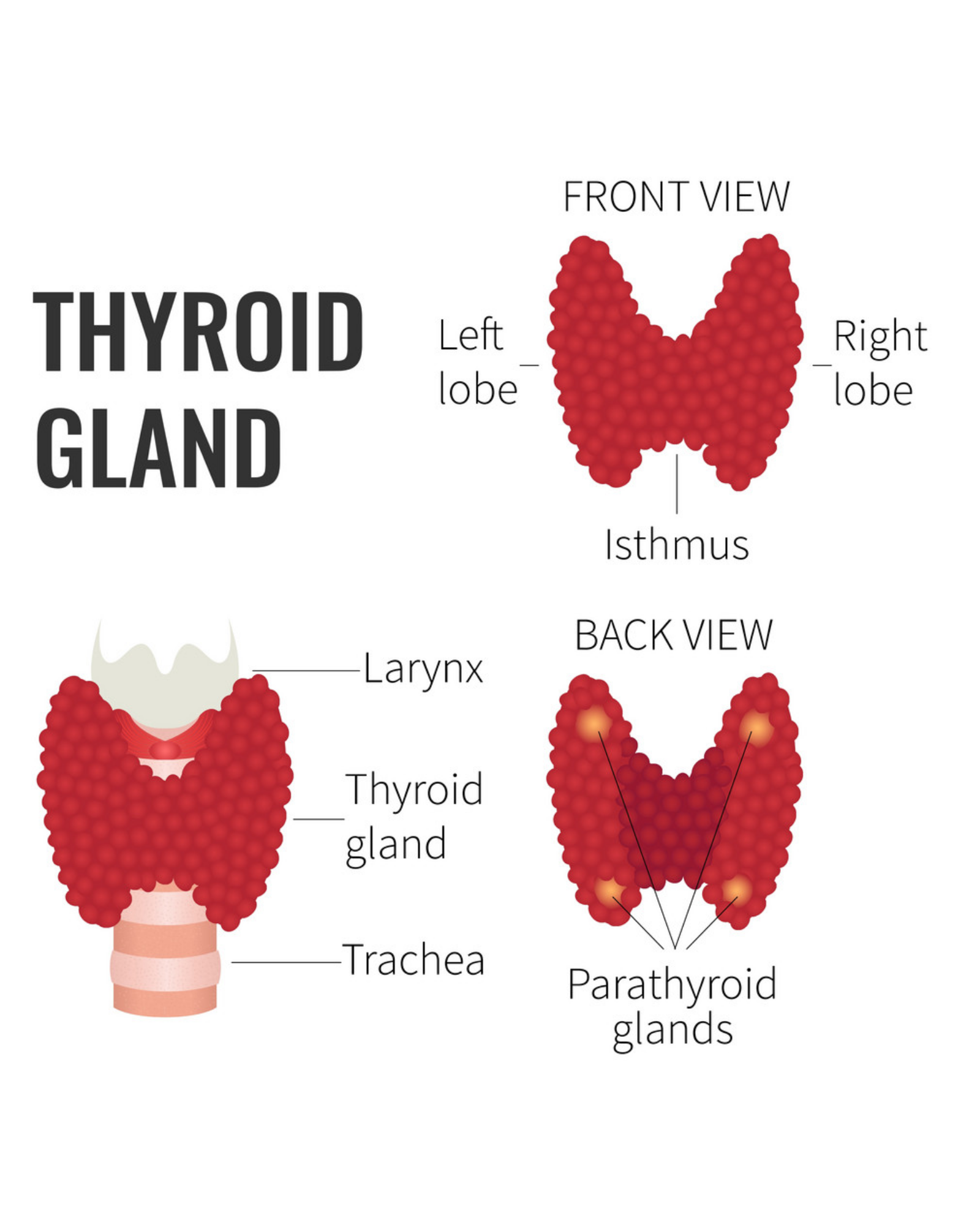Thyroid

The thyroid consists of two lobes, which are situated on both sides of the trachea, near the larynx. In most domestic animals the lobes are connected. The hormone of the thyroid contains large quantities of iodine, which is the active constituent in this case. The formation of the thyroid hormone is controlled by thyrotrophic hormone (TTH), which is secreted by the pituitary.
Thyroid hormone, in turn, inhibits the formation of thyrotrophic hormone, and a balance is thus created between the two hormones in the blood stream. With a deficiency of iodine in the body the formation of thyrotrophic hormone is not inhibited, with the result that the continuous production of this hormone causes the thyroid to enlarge. This enlargement is known as goitre. Further symptoms of decreased production of thyroid hormone (or deficiency of iodine) are:
- Obesity – sugars cannot be metabolised fully
- Dwarfism – in young animals • Hairlessness or loss of hair – in iodine-deficient areas piglets are often born hairless
- Lowered fertility
- Lowered milk production
Parathyroid
The parathyroid consists of two pairs of glands on, or very near, the thyroid glands. They are much smaller than the thyroids. Parathyroid hormone controls the uptake of calcium by the intestine and resorption of calcium from the bones, as well as the excretion of phosphorus in the blood stream. The parathyroid plays a very important role in high calcium intake in dairy cows before the birth of a calf. If the gland’s reaction is lazy, the blood-calcium levels will fall when milk secretion starts, and the cow can get milk fever.
Adrenals
The adrenals lie close to and at the cranial poles of the kidneys. Anatomically a cortex and medulla can be distinguished. Both these areas secrete different hormones.
Cortex. Under the influence of ACTH from the pituitary gland a series of hormones are formed. The following are the most important:
Mineral corticoid: Controls Na:K balance in the blood and the fluid balance in the body. Loss of minerals through impaired function of the adrenal cortex causes more water to be excreted by the body with resultant dehydration.
Gluco corticoids: Essential for the control of glucose metabolism (energy) and exert an anti-inflammatory effect.
Medulla. The hormone adrenalin is produced by the medulla and is responsible for:
- Increased heart rate. More work is done by the cardiac muscles than normal.
- Dilation of the blood vessels of the heart. As a result of the increase in the heart rate and with more forceful contractions a better blood supply is essential.
- Increase in blood pressure. More blood per time unit is forced through the lungs to increase the rate of gas-exchange.
- Increased respiration rate.
- Constriction of blood vessels of the muscles.
- Dilation of the blood vessels of the muscles.
- Mucous- and salivary secretion decreases.
- Increase in blood sugar because more energy is used.
All the above prepare the body for action – the so-called “fight-or-flight” reaction.
Pancreas
In addition to the pancreatic enzymes, which are secreted via the pancreatic ducts into the small intestine, this organ also secretes the hormones insulin and glucagon.
Impairment in the secretion of insulin causes diabetes mellitus. In this case an increase in blood sugar is present, the reason being that permeability of cell walls to blood sugar decreases in the absence of insulin, so that blood sugar cannot be made available to the tissues. Notwithstanding the fact that kidneys normally reabsorb 100 percent of the glucose in the urine, the blood sugar is so high that the kidneys are not capable of resorbing all the glucose, leading to the excretion of glucose in the urine. Glucagon opposes the action of insulin by raising blood glucose levels.
Definition: Permeability The ability of the cell membrane to transport molecules through.
Ovary
The ovaries are the female reproductive organs that produce ova from the Graafian follicles. A Graafian follicle produces oestrogen. Apart from its role in ovulation (production of ovum) it also causes oestrus.
Testis
The testis is the male organ that produces the hormone testosterone and sperm cells. Testosterone is responsible for the development of the secondary male characteristics in the male animal and stimulates the sexual drive.
Thymus
The thymus is involved in the immune system of the body.
Pineal Body
The pineal body regulates the sexual activity of seasonal breeders like sheep and horses. The onset of decreasing day length in autumn stimulates ewes to start cycling. The opposite is true for mares, where increased day length in spring starts the mare cycling.